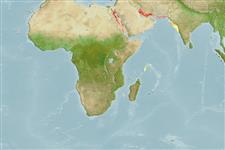>
Anguilliformes (Eels and morays) >
Congridae (Conger and garden eels) > Heterocongrinae
Etymology: Gorgasia: From Greek mithology, Gorgas, -ados = the Gorgone´s head (Ref. 45335).
Environment: milieu / climate zone / depth range / distribution range
Ecologia
marino demersale. Tropical
Western Indian Ocean: Gulf of Aqaba, Red Sea.
Size / Peso / Age
Maturity: Lm ? range ? - ? cm
Max length : 83.8 cm TL maschio/sesso non determinato; (Ref. 33408)
Life cycle and mating behavior
Maturità | Riproduzione | Deposizione | Uova | Fecundity | Larve
Spawning begins early in the morning. From variable colonies in a reef, each eel occupies a burrow it has dug, reaching into the water column to pick out the plankton for food. Prior to spawning, the male and female move their burrows close together; whether the male or the female moves is not known. The male then defends the female from other males, and prolonged and vigorous inter-male combat is common.
On the day of spawning, the male extends out of his burrow toward the female. Both spread their dorsdal fins broadly and the male rubs his head over the female's body. If not ready, the female withdraws into her burrow; if ready, she extends toward the male and wraps her body once or twice around his, bringing her urogenital opening close to his. The pair remains in this position until spawning occurs, which may take up to nine hours or more.
Castle, P.H.J. and J.E. Randall, 1999. Revision of Indo-Pacific garden eels (Congridae: Heterocongrinae), with descriptions of five new species. Indo-Pac. Fish. (30):52 p. (Ref. 33408)
IUCN Red List Status (Ref. 130435)
Threat to humans
Harmless
Human uses
Informazioni ulteriori
Age/Size
Accrescimento
Length-weight
Length-length
Length-frequencies
Morfometria
Morfologia
Larve
Dinamica popolazioni larvali
Reclutamento
Abbondanza
BRUVS
BibliografiaAcquacolturaProfilo di acquacolturaVarietàGeneticaElectrophoresesEreditarietàMalattieElaborazioneNutrientsMass conversion
CollaboratoriImmaginiStamps, Coins Misc.SuoniCiguateraVelocitàModalità di nuotoArea branchialeOtolithsCervelliVista
Strumenti
Special reports
Download XML
Fonti Internet
Estimates based on models
Preferred temperature (Ref.
123201): 25 - 27.4, mean 26.7 °C (based on 34 cells).
Phylogenetic diversity index (Ref.
82804): PD
50 = 0.5001 [Uniqueness, from 0.5 = low to 2.0 = high].
Bayesian length-weight: a=0.00102 (0.00046 - 0.00225), b=3.06 (2.88 - 3.24), in cm total length, based on all LWR estimates for this body shape (Ref.
93245).
Trophic level (Ref.
69278): 3.4 ±0.4 se; based on size and trophs of closest relatives
Resilienza (Ref.
120179): Medio, tempo minimo di raddoppiamento della popolazione 1.4 - 4.4 anni (Preliminary K or Fecundity.).
Fishing Vulnerability (Ref.
59153): Moderate to high vulnerability (54 of 100).
